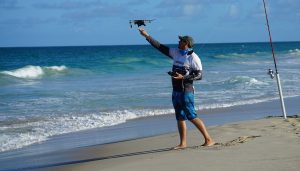Fishing has always been a blend of skill, patience, and a bit of luck. But with the rise of drone technology, anglers are now adding another tool to their tackle box—drones. Drone fishing is becoming a viral trend, offering new ways to catch fish that were previously out of reach. Whether you’re an experienced angler or just starting out, drone fishing can elevate your experience and improve your chances of a big catch.
What is Drone Fishing?
Drone fishing involves using drones to drop bait in precise locations or to scout for fish. Equipped with cameras, GPS, and bait release mechanisms, these drones provide anglers with a bird’s-eye view of the water, allowing for strategic placement of bait and increased success rates.
Benefits of Drone Fishing
- Extended Reach: One of the biggest advantages of drone fishing is the ability to cast your bait far beyond what a traditional rod and reel can achieve. This is especially useful when fishing from the shore, where reaching deeper waters can lead to better catches.
- Precision Baiting: With drones, you can drop your bait in the exact location you want, whether it’s near a school of fish or in a specific spot that’s difficult to reach by casting alone.
- Scouting: The drone’s camera can scout the area, helping you identify schools of fish, underwater structures, or other promising spots without disturbing the water.
- Accessibility: For those with limited mobility, drone fishing can make the sport more accessible. The drone does much of the heavy lifting, allowing anglers to focus on reeling in their catch.

Popular Drone Fishing Techniques
- Bait Dropping: The most common use of drones in fishing is bait dropping. The drone carries the bait to a desired location, then releases it into the water. This method is particularly effective for surf fishing, where reaching deeper waters is crucial.
- Trolling: Some anglers use drones to troll, attaching a fishing line to the drone and moving it slowly over the water to simulate live bait. This technique is still in its experimental phase, but it’s gaining traction among innovative anglers.
- Fish Spotting: Using the drone’s camera, anglers can spot fish from above, identifying schools or individual targets to drop bait on.
Legal and Ethical Considerations
Drone fishing is not without its controversies. Regulations vary by location, so it’s essential to check local laws before heading out. Some regions have restrictions on drone use in public spaces or near wildlife. Ethical considerations also come into play, as some argue that drone fishing gives an unfair advantage and disrupts the natural balance of the sport.
Choosing the Right Drone
Not all drones are suitable for fishing. When selecting a drone, consider the following:
- Payload Capacity: Ensure the drone can carry the weight of your bait and release mechanism without compromising its flight capabilities.
- Battery Life: Fishing trips can be long, so opt for a drone with extended battery life to avoid frequent recharges.
- Water Resistance: Since you’ll be flying over water, a water-resistant drone is a must to protect your investment from accidental splashes or crashes.
- Camera Quality: A high-definition camera is crucial for spotting fish and identifying the best locations to drop bait.
Drone Fishing: The Future of Angling?
As drone technology continues to evolve, its role in fishing is likely to expand. While traditional fishing methods will never go out of style, drone fishing offers a fresh, tech-savvy approach to the sport. Whether you’re looking to catch that elusive trophy fish or just want to try something new, drone fishing might be the next big thing in your angling adventures.
Image: WSJ





